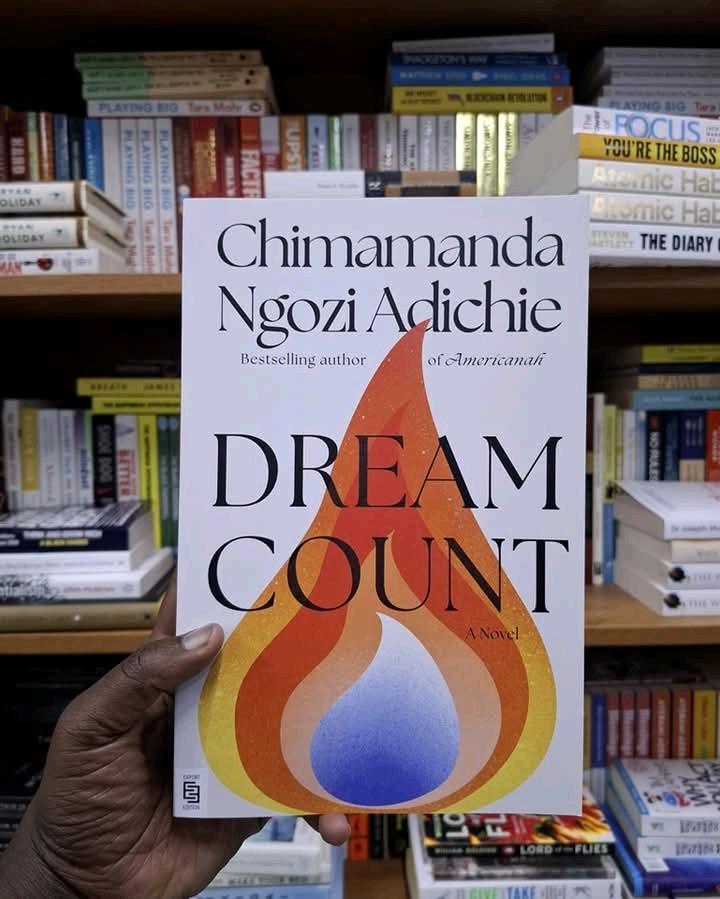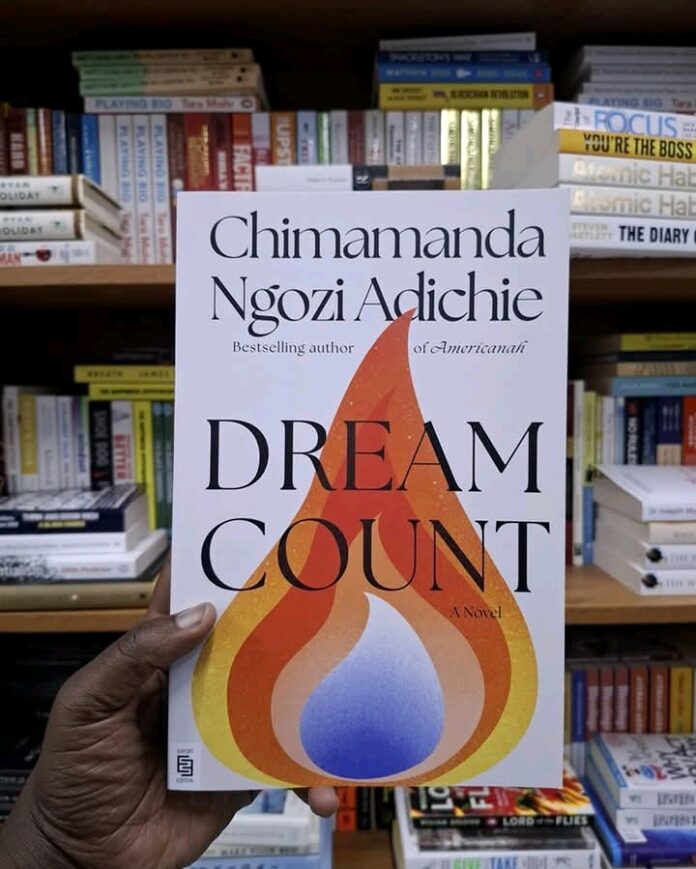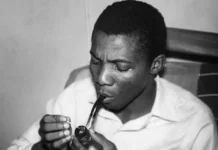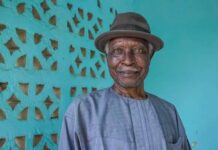📢 Follow our WhatsApp Channel for the latest literary updates!
Award-winning Nigerian author Chimamanda Ngozi Adichie returns with a deeply moving and timely novel, Dream Count (2025), marking her long-anticipated return to fiction after more than a decade. This powerful, character-driven book weaves together the lives of four African women navigating identity, love, motherhood, and trauma against the isolating backdrop of the COVID-19 pandemic.
Dream Count is a novel born of personal grief and global crisis. It was written in the wake of personal tragedies: the deaths of her father in 2020 and her mother in 2021. Her earlier essay Notes on Grief (2021) processed the loss of her father; Dream Count is a more expansive, fictionalised reckoning with grief, womanhood, and emotional resilience, shaped by her mother’s memory.
Adichie has previously gained global recognition through novels like Purple Hibiscus, Half of a Yellow Sun, and Americanah. Her TED Talk “The Danger of a Single Story” and essay We Should All Be Feminists have also made her a leading voice in global feminist and cultural discourse.
If you’re searching for a thought-provoking read that captures the emotional complexity of womanhood, Dream Count deserves a top spot on your 2025 reading list.

Plot Summary of Dream Count
Dream Count is a character-driven novel set during the COVID-19 pandemic. It tells the intersecting stories of four African women: Chiamaka, Zikora, Kadiatou, and Omelogor. Each deals with personal turmoil, societal pressure, and the pursuit of emotional truth.
Structured in five narrative sections, the novel switches between first- and third-person perspectives to capture each woman’s inner world and relationships.
Section 1: Chiamaka
Chiamaka (often called Chia) is a Nigerian travel writer stuck alone in Maryland during the early COVID-19 lockdowns. Far from her family in Nigeria, and distanced from her friends, she sinks into introspection.
Once energetic and career-driven, Chia now feels lethargic. She questions whether she’s wasted her life chasing the wrong things and the wrong romantic relationships.
She reflects on three major past relationships: Darnell, who she tried to mold herself for; Chuka, who disappointed her once she realised he wasn’t what she truly wanted; and the Englishman, whose brief presence left a hollow ache.
Her grief deepens after her friend LaShawn’s mother dies of COVID, a moment that makes Chia question her own mortality and sense of meaning.
Though she stays in touch with her cousin Omelogor, her pregnant best friend Zikora, and her housekeeper Kadiatou, the isolation reveals how emotionally disconnected she feels from them all.
Section 2: Zikora
Zikora is a successful Nigerian lawyer in Washington, D.C. who goes into labour unexpectedly. Her boyfriend, Kwame, had abandoned her upon learning of the pregnancy and completely cut off contact.
In pain and alone, Zikora is supported by her traditional, emotionally distant Nigerian mother who flies in to help her.
During the painful labour and postpartum period, Zikora wrestles with her feelings of betrayal, her longing for connection, and unresolved resentment towards her mother. Surprisingly, her mother begins to open up about her own difficult marriage.
She repeatedly reaches out to Kwame to inform him of their son’s birth. But Zikora is ultimately blocked and left to accept her reality as a single mother. She begins the process of redefining her identity beyond romantic attachment.
Section 3: Kadiatou
Kadiatou (or Kadi) is a Guinean immigrant and housekeeper. She shares her life story in this heart-wrenching section.
Raised in a small village, Kadi grew up in the shadow of her vivacious sister, Binta. After their father’s death, both girls lived under their uncle’s control. Binta died tragically during a medical procedure, and Kadi was married off to Saidou.
After losing both her husband and infant son, Kadi gave birth to another daughter, whom she also named Binta, and struggled to survive.
She later rekindled her relationship with Amadou, her childhood love, and moved to the U.S., where he was eventually imprisoned for drug possession. Alone again, Kadi supported her daughter through hotel cleaning jobs and occasional domestic work for Chiamaka.
In a devastating turn, Kadi is raped by a hotel guest, a man with power and privilege. When she reports the crime, she is met with skepticism, even from her assigned lawyer. The trauma isolates her further, but she clings to her daughter and her will to survive.
Section 4: Omelogor
Omelogor is Chia’s cousin. She is a bold and unconventional former banker living in Abuja, Nigeria.
Reflecting during the Nigerian lockdown, she considers the cost of her choices: how she leaves behind a high-powered career to study pornography in graduate school in the U.S., and how she maintains a blog called For Men Only that critiques patriarchal behaviours with biting wit.
Although fiercely independent, Omelogor admits her secret desire for marriage and emotional connection, a longing that contradicts her public persona. She recalls failed romantic relationships and wonders whether her outspokenness and ambitions alienated potential partners.
Her section adds satirical insight into gender norms in Nigeria and the U.S., particularly around sex, power, and women’s choices.
Section 5: Return to Chiamaka
In the novel’s final section, Chia prepares for the end of lockdown. She reconnects more deeply with her friends and is particularly drawn into Kadi’s unfolding legal case.
When news breaks that Kadiatou’s attacker will not be prosecuted, Zikora and Omelogor are devastated. Chia, however, visits Kadi’s home to share the news and is surprised to find Kadi and her daughter Binta celebrating. Their joy seems incongruous until Chia realises they are simply relieved it is over. The legal fight, the retraumatisation, and the lack of hope for justice had become unbearable. For Kadi, peace means moving forward without permission from the system that failed her.
Chia joins them in their quiet, defiant celebration, choosing shared human connection over outrage or despair.

Themes in Dream Count
Love and Desire to Be Truly Known
At the heart of Dream Count lies a profound and persistent question: “Is it possible to be truly known by another human being?” This theme threads through the lives of all four protagonists (Chiamaka, Zikora, Kadiatou, and Omelogor), each of whom yearns for a love that goes beyond surface-level affection or societal validation. They seek a deep emotional intimacy where they can be fully seen, understood, and accepted without needing to shrink or reshape themselves.
Chiamaka embodies this desire most directly. In her introspective solitude during the COVID-19 lockdown, she revisits past relationships, and tries to understand why none of them offered the kind of love she longed for. Her reflection reveals a pattern of emotional compromise; moments when she muted parts of herself to be loved, only to end up feeling more alone. Her longing is for a connection where her flaws and contradictions are met with recognition, not rejection.
Zikora, too, is haunted by her need to be known and loved, particularly by Kwame, the father of her child. Her devastation when he abandons her is compounded by the erasure of the emotional bond she thought they shared. As she labours and recovers from childbirth, she begins to understand that real love (like the tentative reconnection she forms with her mother) might arise in unexpected places and often requires vulnerability, not idealisation.
Kadiatou’s experience is perhaps the most tragic lens through which this theme is explored. Her assault and the system’s failure to believe her reveal a world where being truly known—being heard, validated, and believed—is denied to those with the least power. Yet, her resilience and the relationship she shares with her daughter Binta offer a more grounded, maternal form of love rooted in sacrifice and shared survival.
Omelogor, outwardly independent and intellectually fearless, confesses that beneath her outspoken critiques of patriarchy lies a quiet wish to be known and loved as she is. Her reflections suggest that even those who seem the most self-contained are not immune to the longing for emotional closeness and recognition.
Theme of Motherhood
Motherhood is portrayed as complex, multifaceted, and emotionally charged in Dream Count. It is explored through diverse experiences of birth, loss, duty, and identity. Rather than presenting motherhood as a single, unified experience, Adichie uses her four protagonists to examine the many ways it can define or destabilise a woman’s sense of self.
Zikora’s journey into motherhood is perhaps the most central and emotionally raw. After being abandoned by her boyfriend, Kwame, upon revealing her pregnancy, Zikora gives birth alone, physically and emotionally overwhelmed. In the absence of romantic support, she must lean on her distant and traditionally-minded mother, with whom she has a strained relationship. As she recovers from childbirth and begins to bond with her newborn son, Zikora starts to recognise the silent sacrifices her mother once made; ones she had dismissed or misunderstood. This evolution not only redefines her understanding of her mother but reshapes her sense of what it means to be a mother herself.
For Kadiatou, motherhood is marked by tragedy and endurance. After losing her first child in infancy and then becoming a widow while pregnant again, she fights to survive and raise her daughter, Binta, alone. Her maternal love is fierce but quiet, expressed in hard labour, sacrifice, and unwavering protection. Her experience as a low-income immigrant mother, struggling to provide for her daughter in a hostile environment, adds layers of class and race to the theme of motherhood. The novel shows how Kadiatou’s identity as a mother becomes both her strength and her burden, especially after she is assaulted and the justice system fails her; forcing her to choose between retribution and peace for the sake of her child.
Chiamaka, though not a mother herself, reflects deeply on maternal expectations and her own strained relationship with her mother. Their emotional distance, shaped by cultural expectations and generational differences, colours Chiamaka’s ideas about womanhood, duty, and fulfillment. Her interactions with Kadiatou and Binta at the end of the novel, hint at a broader, more symbolic form of motherhood; one that is less about biology and more about nurturing, empathy, and emotional presence.
Ultimately, Adichie uses the theme of motherhood to explore what women inherit and what they choose to pass on, both biologically and emotionally. Motherhood in Dream Count is far from being idealised. It is real, messy, painful, and powerful. It becomes a lens through which the characters reckon with their pasts, their roles in the world, and their capacity to love and be loved.
Theme of Trauma and Systemic Injustice
One of the most harrowing and politically charged themes in Dream Count is the depiction of trauma, particularly sexual violence, and the ways in which institutional systems fail to protect and support survivors.
This theme is embodied most directly in the story of Kadiatou, a Guinean immigrant working as a hotel cleaner in the U.S., who is raped by a wealthy hotel guest. Rather than being met with compassion, credibility, or meaningful legal support, Kadiatou finds herself doubted at every turn. Her assigned lawyer is unresponsive and dismissive. The authorities treat her story with procedural detachment, and the media reduces her trauma to a predictable narrative that they’ve “heard many times before.” Her assault becomes another case number, another disposable story in a system designed to protect power, not people.
Kadiatou’s experience is a powerful critique of how trauma is often silenced, dismissed, or flattened by institutions, especially when the survivor is a poor, black immigrant woman. The novel draws a parallel to real-world cases like the one involving Nafissatou Diallo and Dominique Strauss-Kahn, where class, race, and public perception heavily influenced the response to sexual assault claims.
What makes this theme even more potent is how Kadiatou processes the aftermath of her trauma. While others expect her to pursue justice through the courts, her ultimate decision not to continue the legal fight is not framed as defeat, but as a deeply personal act of self-preservation and peace. She rejects a system that re-traumatises her. And she chooses her mental and emotional wellbeing over a legal process that never treated her with dignity.
Theme of Female Solidarity
Chimamanda Ngozi Adichie draws a moving portrait of female solidarity as a lived, often subtle, form of emotional resilience. Through the relationships among Chiamaka, Zikora, Kadiatou, and Omelogor, the novel demonstrates how women quietly sustain one another through emotional labour, shared understanding, and compassionate presence, even across differences in class, nationality, or circumstance.
Though the four women differ in many ways (professionally, socially, and culturally), they are united by their shared experience of navigating a world that misunderstands, underestimates, and exploits them. Their moments of connection are often quiet: a conversation during a crisis, a wordless act of comfort, a phone call that pierces isolation.
One of the most expressive forms of solidarity occurs in the final section of the novel, when Chiamaka visits Kadiatou after the legal case against her rapist is dismissed. Chiamaka simply sits with Kadiatou and her daughter, and joins them in an unexpected moment of peace. This act demonstrates what it means to stand with someone, even when words fail.
Zikora and Omelogor also display solidarity in their reactions to Kadiatou’s ordeal. Though physically distant, they are emotionally invested, horrified by the injustice she faces, and connected by a shared sense of grief and helplessness.
Theme of Pandemic Isolation
Dream Count uses the COVID-19 pandemic as a catalyst for deep psychological and emotional reckoning. The physical isolation imposed by lockdowns becomes a powerful metaphor for the internal isolation the characters have long carried within themselves; an estrangement from past loves, unspoken traumas, and unfulfilled desires that now resurfaces in the stillness of pandemic life.
Chiamaka, perhaps the most affected by this isolation, is alone in her home in Maryland, separated from family in Nigeria and unable to travel. Without the distractions of daily life or the comfort of physical connection, she is forced into intense introspection. Memories of former relationships, career ambitions, and youthful dreams flood back, unfiltered. Her restlessness and lethargy deepen as she questions the choices she’s made, the love she’s lost, and whether she has lived an emotionally meaningful life. Her pandemic experience mirrors the emotional paralysis many faced during lockdown.
For Zikora, the pandemic compounds the loneliness of single motherhood. Isolated while pregnant, abandoned by her partner, and emotionally distant from her own mother, she faces childbirth in a heightened state of emotional vulnerability. The restrictions of the pandemic magnify her sense of abandonment and intensify her search for emotional connection and reassurance.
Even Omelogor, back in Nigeria, experiences a form of spiritual and intellectual confinement. As Abuja goes into lockdown, she reflects on her choices: abandoning a prestigious banking job, seeking knowledge in America, and returning home with unanswered questions. The quiet imposed by the pandemic creates space for re-evaluation of identity, especially for a woman who has always prided herself on independence and clarity.
Kadiatou’s isolation is more complicated. She is already existing on the margins of American society as a low-income immigrant and domestic worker. The pandemic pushes her further into invisibility. Her trauma is made worse by her physical and social disconnection from any meaningful support system. In her case, the lockdown intensifies her sense of helplessness.
Across all these narratives, Adichie captures the way the pandemic exposed emotional wounds that had long been suppressed. The silence and stillness of lockdown function like a mirror that forces the characters to face truths they had long evaded: past regrets, unprocessed grief, and unacknowledged desires.
Theme of Cultural Dislocation
Cultural dislocation is the feeling of being emotionally or psychologically unmoored from a sense of home or identity. It is a recurring and deeply felt theme in Dream Count. Through the lives of Chiamaka, Zikora, and Kadiatou, all African women living in the United States, Chimamanda Ngozi Adichie explores the emotional cost of migration, the instability of identity, and the tension between where one comes from and where one is trying to belong.
Each woman’s immigrant experience is shaped by her socioeconomic status, race, and personal history; factors that influence how welcome, safe, or seen she feels in her adopted environment.
Chiamaka has lived in the U.S. for years, but still exists in a space of cultural in-betweenness. While she is financially secure and professionally respected, she experiences a quiet emotional disconnection from both her native Nigeria and her American surroundings. During the lockdown, she becomes acutely aware that she belongs nowhere completely. Her memories of home are idealised yet distant; her reality in America is functional but lonely.
As for Zikora, her pregnancy out of wedlock and the subsequent abandonment by her partner trigger a cultural tension. She grapples with shame and judgment (both internalised and projected) based on her upbringing and Nigerian social norms. Meanwhile, the American setting offers little emotional support, only legal rights.
Kadiatou’s story adds another critical layer. As a Guinean immigrant and working-class woman, her experience is marked by economic precarity and systemic invisibility. She cleans hotel rooms and does domestic work, labour that is physically taxing and socially undervalued. After her assault, her status as an immigrant becomes a liability. The novel shows how the intersection of race, class, and immigrant status multiplies her disenfranchisement. Kadiatou’s longing for dignity and stability, both as a woman and as a mother, is constantly undermined by a system that sees her as foreign, expendable, and voiceless.
Using these intersecting stories, Adichie critiques the limited narratives that Western society assigns to African immigrants, particularly through a moment where Chiamaka pitches a travelogue idea to a white editor, only to be told she should write about rape in Congo instead. African stories continue to be reduced to trauma and poverty tropes, even as African women like Chiamaka live rich, complex, and modern lives.

Characters in Dream Count
Chiamaka (Chia)
Chiamaka is the novel’s protagonist and narrative anchor. She is a Nigerian travel writer living alone in Maryland during the COVID-19 pandemic. Her introspective voice opens and closes the novel.
At the start of the novel, Chiamaka is physically isolated due to the pandemic and emotionally suspended in a fog of unresolved emotions. She spends most of her days in stillness; replaying her past relationships, questioning her decisions, and mourning the idea that no one has ever truly seen her. This deep existential longing for emotional intimacy is the central engine of her character arc.
From her ongoing communication with Zikora, Omelogor, and Kadiatou, she begins to understand that connection can also be found in female friendship, in acts of listening, showing up, and shared grief.
By the end of the novel, when she chooses to sit quietly with Kadiatou and her daughter instead of reacting with outrage over the legal injustice, she demonstrates growth: from seeking validation through romantic love to offering and accepting unspoken solidarity.
Zikora
Zikora is Chiamaka’s best friend and a highly accomplished Nigerian lawyer living in Washington, D.C. Her character arc is centred on the abrupt collapse of her romantic dream and her painful rebirth into motherhood.
When she tells her partner, Kwame, that she is pregnant, he abandons her without a word. Alone during the pandemic, Zikora is thrown into early labour and must rely on her stern, emotionally distant mother, who arrives from Nigeria.
Much of Zikora’s emotional development unfolds during and after childbirth. The physical pain of labour mirrors her emotional rupture. It forces her to confront Kwame’s betrayal and her own misconceptions about love, independence, and what motherhood means. At first, she feels ashamed and destabilised by her situation, but gradually, she comes to see strength in her vulnerability.
The novel also carefully examines Zikora’s tensed relationship with her mother. From their conversations, Zikora begins to see her mother not just as judgmental, but as someone who, too, bore pain in silence. Their fragile reconciliation, rooted in shared experience, adds depth to the novel’s exploration of intergenerational trauma and healing.
Kadiatou (Kadi)
Kadiatou is Chiamaka’s housekeeper and a Guinean immigrant living in the United States. She also works as a hotel cleaner and is a single mother raising her daughter, Binta. Her character is the emotional and ethical conscience of the novel.
Kadiatou’s life has been shaped by profound loss and hardship. Her early years in Guinea are marked by the death of her sister Binta, and her subsequent pressured marriage ends in tragedy when both her infant son and husband die.
Alone, she gives birth to her daughter (also named Binta) and eventually migrates to the U.S. with her childhood love, Amadou, who later ends up incarcerated. Kadi is left to navigate the brutal economics of immigrant survival, juggling hotel cleaning with housework for families like Chiamaka’s.
Her world is shattered again when she is raped by a wealthy hotel guest. Instead of receiving protection or empathy, Kadiatou is doubted by the legal system, her lawyer, and society at large. Her trauma is amplified by institutional disbelief and silence.
Yet what makes Kadiatou’s arc so compelling is her refusal to be defined by victimhood. Rather than continuing a battle that retraumatises her, she ultimately chooses to step away from the legal process. She reclaims her narrative by asserting her right to peace, on her own terms.
Omelogor
Omelogor is Chiamaka’s cousin, a Nigerian woman who has undergone a dramatic life shift from a high-powered banking career in Abuja to graduate studies on pornography in the United States. She brings a sharply feminist, satirical, and intellectually provocative perspective to the novel.
Omelogor is bold, articulate, and outspoken. Her decision to leave behind a lucrative career in finance to study sex, gender, and power through pornography is a radical one in the context of Nigerian societal expectations. She runs a blog called For Men Only, where she deconstructs male entitlement and offers satirical advice to men from a feminist standpoint. Her character challenges traditional notions of success, gender roles, and marriage.
But beneath her confidence and sharp intellect lies a subtle emotional tension: Omelogor, for all her independence, longs for connection and love. She admits almost guiltily that part of her still desires marriage, even as she critiques it as a patriarchal institution. This inner contradiction is never resolved cleanly, and that’s the point: Omelogor is representative of the modern woman who resists being boxed in by either traditional or feminist expectations. She is a woman who can simultaneously reject social roles and desire their emotional rewards.
As the pandemic lockdown reaches Abuja, Omelogor enters a period of reflection on her past lovers, her career choices, and the limits of radical independence. Her lockdown is quieter than the others’, but emotionally rich. Her blog becomes a platform for critique and catharsis.
Kwame
Kwame is Zikora’s former partner and the father of her child. He is more of a narrative function than a fully fleshed-out character.
Kwame’s defining action is his complete abandonment of Zikora upon learning of her pregnancy. He disappears from her life, refuses to answer her calls, and blocks her number even after the birth of their child. In doing so, he becomes a symbol of the broader emotional cowardice and lack of accountability often seen in male characters across the novel.
Zikora’s Mother
Zikora’s mother is a traditional Nigerian woman, emotionally reserved and bound by cultural expectations. She travels to the U.S. to assist Zikora during her childbirth, and her presence becomes a key part of the novel’s exploration of intergenerational motherhood.
At first, Zikora’s mother seems stoic, judgmental, and distant. She disapproves of Zikora’s unwed pregnancy and makes few attempts to offer verbal comfort. However, during and after Zikora’s labour, she begins to open up in small, significant ways. She shares stories from her own marriage and motherhood, offering glimpses into the emotional burdens she carried in silence.
Through this slow thawing, Zikora begins to reframe her understanding of her mother, not as cold, but as someone who lived in a world where emotional restraint was survival. Their evolving relationship becomes a deeply moving subplot that adds texture to the theme of how motherhood is inherited, misunderstood, and sometimes reconciled across generations.
By the end of her visit, Zikora is able to express affection and appreciation for her mother; something she might not have thought possible at the beginning of the novel.
Binta
Binta is the young daughter of Kadiatou. She is named after her late aunt who died tragically in Guinea. While Binta does not have much dialogue, she plays a symbolic and emotional role in the narrative.
As a child, Binta is a living embodiment of what Kadiatou has fought to protect through years of loss, trauma, and migration. She represents hope, continuity, and the future. Her innocence and joyful presence stand in gentle contrast to her mother’s burdened life.
At the end of the novel, she and her mother celebrate relief, closure, and each other after Kadiatou’s case is dropped.
Literary Devices in Dream Count
1. Framing Narrative: The novel is divided into five sections, with stories told from the perspectives of four different women, connected through relationships, themes, and shared experiences. This interwoven narrative structure allows Adichie to explore womanhood from multiple angles. It allows for multiple truths to coexist and lets the reader compare the internal lives of each woman
2. Flashback: Adichie frequently uses flashbacks to explore her characters’ backstories. These non-linear memories reveal hidden traumas, past relationships, and formative experiences.
3. Internal Monologue: Characters, especially Chiamaka and Zikora, are rendered through internal monologue. Their thoughts are fragmented, repetitive, and emotionally raw. This technique immerses readers into the characters’ inner emotional worlds and mirrors the mental isolation many felt during the pandemic.
4. Foil Characters: The women contrast each other in values, experiences, and perspectives They act as foils that highlight each other’s journeys. For instance, Chiamaka is romantic and idealistic about love, whereas Omelogor is more skeptical and guarded. Zikora is emotionally open, while her mother remains reserved and restrained. Similarly, Kadiatou, a working-class immigrant, stands in contrast to Chiamaka, who is a middle-class expatriate.
5. Irony: Adichie uses dramatic and situational irony to reveal contradictions in cultural norms and systemic structures. For instance, Chiamaka pitches a travelogue but is told to write about rape in Congo instead. The irony is that the novel itself ends up telling a rape story as human experience rather than “poverty porn” in a way that defies the editor’s narrow expectations.
6. Allusion: Adichie alludes to real-world events, such as the Dominique Strauss-Kahn case (mirrored in Kadiatou’s assault), and references her own nonfiction (like Notes on Grief), grounding the novel in contemporary global context.
7. Juxtaposition: The novel frequently juxtaposes contrasting experiences to reveal inequalities and emotional contradictions. A cursory look at the pandemic experiences of Chiamaka and Kadiatou confirms this. Chiamaka’s pandemic experience is one of existential malaise in a quiet suburban home, while Kadiatou’s is one of physical risk, economic precarity, and life-altering trauma.
Related: 10 African Women Writers to Know in 2025
Receive Literary Updates through our Social Media Channels:
- WhatsApp: Literature PADI
- Telegram: Literature PADI
- YouTube: @literaturepadi
- Facebook: Literature PADI











